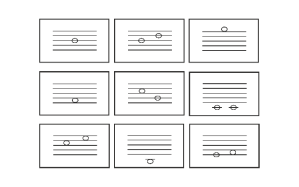First of all, the obvious question is what sight-reading really is.
It is a skill where you play or sing as many correct notes with rhythmic values as possible without loosing the undergoing pulse and deliver some sort of musical sense from a written music score you haven’t seen before.
Suppose you’re given a new piece of written music, if you start reading by identifying each individual note and ignoring the rhythmic value, that’s not sight-reading. That act belongs to the process of ‘learning the notes’. Then what does sight-reading actually involve? In sight-reading, you don’t have time to learn the individual notes before you play what’s written. Sight-reading skill depends on how quickly your brain can process the patterns you see on the score into certain hand/arm movements, which are picked up by fingers. So, the first thing you need to do is to change the way you see the series of notes at a time. I say, ‘pattern recognition’ is the first and the most important elements in developing sight-reading skill.
So, what does pattern recognition mean? It’s basically recognising the distances (or intervals, in a technical term) between a series of notes. But to get there, firstly you need to be able to clearly ‘recognise’ whether the note you see on the stave is either a space note (a note sits between 2 lines on the stave, or dangles down from a line, or sit on a line) or a line note (a line goes through a note) as quick as you can.
You could start by picking up any written music you have and test your quick recognition skill. Let’s say, let your eye pick and follow only the line notes from the beginning to the end of the music. You don’t need to identify the name of the notes, just recognise the pattern of the note. Does your eye follow the line of notes smoothly without stopping? If not, no worries. It’s just that your brain is not used to process the information in a new way yet. All you need to do is to train it by doing this drill over and over until you get used it, and then you eventually speed up quite significantly. This sort of game-orientated drill is very useful. (Dr. Kawashima might call it, ‘sight-training’!) It doesn’t take much of your mind strength, so you can do it even when you’re tired. In fact, it actually wakes up your mind, as you’d notice. For that reason, I often do a similar drill game with my very young pupils. So, in my teaching practise, sight-reading skill building begins after a couple lessons in before they can even read music! I have this set of cards (about 25) I made which look like this:
What do you see here? Some cards have one note; line or space note. Some have two notes; only line or space notes. Or both.
As an example, here’s how I do with my young pupils:
Stage 1
I hold the cards, and show one card at a time and let them ‘say’ which kind it is, line or space note. (To start with, I use the cards that have only one note, then two notes of the same kind mixed in later on)
Stage 2
Now pupils hold the cards and place them one by one into 2 groups onto the floor, one side is for the line notes only, the other for the space notes. For the first time, saying which kind it is (this is to check if they say what they meant, sometimes brain thinks the right thing but it comes out wrong) and the second time, without saying which kind it is as they place each card onto the floor. Remembering to put the cards in the correct places as they go along is another organising skill, which is worth developing.
Stage 3
I mix in another kind of cards, which have both line and space notes. I call these cards ‘odd one out’. And do the same drill as in Stage 1 & 2. In making the card into 3 groups, I ask them to put the ‘odd one outs’ in the middle. And when they get better at it, I time it with a stopwatch to show how quickly they can finish the game. This definitely brings their focus level up and usually speed up significantly!
This game-orientated drill seems like a trivial process but it’s actually helping to develop a reflex movement of muscles linked to visual input. That’s one of the very basic elements you need to possess to be able to sight-read efficiently.
In part II, I’m going to talk about the next stage of learning how to sight-read, ‘recognising the intervals’. Still no real ‘reading’ (naming the notes) involved there yet!
